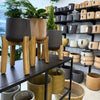Artificial lighting for maids

Sufficient light is one of the most important conditions for plants to survive. Thanks to it, they can photosynthesize and thus ensure their sustenance with the help of carbon dioxide and water. But we cannot look at light only as a source of sustenance for plants. It is also important for many chemical reactions and cell signaling - for starting new growth or the flowering and fruit formation phase, for the new formation of chlorophyll, for controlling the germination phase and much more.
When growing indoor plants, however, you can often encounter problems with insufficient lighting, especially during the winter months. The plants receive little light and the light period is usually short enough for them to thrive healthily. The plants are then elongated, with few leaves, blooming with marigolds and the like. You can read advice and tips on what you can do to help plants better manage this period (article) in this article of ours . If you need to check if your indoor plants are positioned correctly (article) and if they receive enough light, read this article .
Today we will focus on one quick, simple and very effective solution for lack of light - grow light . We will explain the mysteries of artificial grow lighting and explain what is important in this regard for plant happiness.
A bit of theory to start with
Most of the articles on this topic go into the nitty-gritty details, and that puts a lot of people off the subject right off the bat. But we will try to present here only the most important information and hopefully we will be able to explain it simply enough to understand the topic. Therefore, we do not want to go into complete details, but we will not forgive ourselves a little theory.
Solar radiation , from which plants receive energy for photosynthesis, is a type of electromagnetic radiation/wave that can be measured by wavelength. According to these measured values, it is further divided into several types of radiation.
We promised simplicity, so now we will only deal with the so-called visible light , which can be distinguished by the human eye, creates a spectrum of colors (violet, blue, green, yellow, orange and red) and ranges between 380 nm and 780 nm.
This range also includes the so-called photosynthetically active radiation ( FAR, English photosynthetically active radiation - PAR ), which corresponds to the range of wavelengths 400 - 700 nm , and plants, as the name suggests, can use this light for photosynthesis. However, some chemical reactions taking place inside the plant are also activated by other types of radiation - e.g. UV radiation (10 - 400 nm). This radiation is harmful to living organisms, which is used in disinfection and in the removal of mold and germs of other diseases. But a small amount of UV radiation also has some benefits for plants. It is important for their metabolism, for the development of their colors and fragrance oils and, for example, when growing marijuana, it is also used to increase the production of THC.
It's probably no surprise that each type of light has a different color. Some lighting appears to us as "warm" (warm white - more yellow to orange) and others are "cold" (cold white - more blue). This phenomenon is called chromaticity temperature or color temperature. This value is given in Kelvin (K) and the higher the value, the more blue the light. For the sake of interest, a warm white fluorescent lamp has around 2500 K to 3000 K and cold white, used for example in warehouses or offices, has around 4000 K. Fluorescent lamps with a chromaticity temperature of 5400 K and more are referred to as daylight fluorescent lamps .

Photo: Color temperature of different light bulbs
How many colors are needed?
If you have already browsed the offer of grow lights, you have surely noticed that they are available in several color designs. Even natural sunlight consists of the entire color spectrum, as we described above, and if these colors are combined together, only white light is produced. Only at sunset or sunrise does the sun sometimes appear red to us, because its radiation has to penetrate the widest part of the atmosphere, and the individual colors cannot all combine together, because some of them penetrate to a greater extent.
Plants are most comfortable with light in the extreme regions of the color spectrum, namely in the blue and red regions. Even photosynthesis itself is most efficient in the red zone, when the growth of new leaves and the plant as such is stimulated. But in order for the plant to thrive well, it must have access to all the colors of the spectrum.
It clearly follows from this that for artificial lighting of indoor plants (without demands for increased production or constant flowering) so-called full- spectrum lights , which together contain all individual colors, are most suitable.
The blue color (400 - 499 nm) helps plants make chlorophyll, a photosynthetic pigment that absorbs the blue and red parts of the color spectrum and makes plants look green to our eyes. It is involved in the growth phase of seedlings and young plants, as well as in the creation of aromatic oils. Blue light mainly consists of metal-halide lamps, so-called MH lamps, and CFL energy-saving fluorescent lamps (CFL - compact fluorescent lamp ).
Green color (500 - 550 nm)
It could be said that green color is the least necessary for plants. Even the color pigments that can absorb the green color of the spectrum are stored quite deep in the leaves.
Red color (600-699 nm) is on the opposite side of the color spectrum and is needed for vegetative propagation. It helps young plants to form roots and seeds to germinate better. Adult plants will use it to produce flowers and fruits. It is often used to artificially extend the light cycle, which is used when planting flowers. The red color of the spectrum is provided by HPS sodium discharge lamps (HPS - high-pressure sodium ), which replace summer sunlight.
Far red - far red color (730 nm)
The wavelength of this color is already beyond the limits of photosynthetically active radiation, but the plant converts part of this radiation into classic red and can also use it. It serves as an auxiliary signal for plants to set flowers.

Photo: Led Grow bulb SANSI 36W
Types of lights
Most often, grow lights are in the variant of purple light or pure white. Violet lights are created by a combination of blue and red radiation, which is very suitable especially for young plants. But the question is whether it is also pleasant for your eyes. If you have plants in your interior as an aesthetic addition, you will probably choose broad-spectrum bulbs that emit the visible spectrum in white. These white grow bulbs give plants a full color spectrum that they will use throughout their life cycles. It is an indisputable advantage over one/two-component spectral lighting or sodium discharge lamps.
Classic light bulbs with tungsten filament and fluorescent lamps are not suitable for cultivation. Halogen fluorescent lamps are also not suitable for cultivation, as they represent, among other things, an environmental burden. LED lights thus become the best solution for artificial lighting of plants.
LED bulbs and strips may seem more expensive at first for the first investment, but believe me, they are much cheaper to run and also kinder to the planet. They save up to half more consumption than a regular energy-saving light bulb and have an extremely long life. They also don't mind frequent switching on and off, but you probably won't use this for consecrating plants. You can get a timer or time clock to have perfect control over the amount of light that reaches the plants. You don't have to think about turning it on every day, and at the same time, you won't forget to turn off the light at night, exposing the plants to unnecessary stress by not respecting their natural light cycle.
We at Dej mi požemovku have extensive experience with SANSI LED GROW fluorescent lamps , which we use in the store and in the warehouse. They serve us so well that we decided to offer them to you as well.
To begin with, you can try the bulb with the smallest power (15W), but we also have more powerful bulbs SANSI 24W and SANSI 36W in our offer. All these bulbs have an E27 socket, which you screw into the classic socket in most lamps, lamps and chandeliers. Even the most powerful bulb does not create unnecessary heat that could burn the leaves, because all types of bulbs are equipped with a ceramic base that dissipates the generated heat.
We recommend installing these bulbs at a height of 30 - 120 cm above the plant , depending on the power of the bulb and the required amount of illuminated plants. You can adjust the lighting time depending on the type of plant and its life stage. As a rule , 8-12 hours of lighting per day is sufficient for most plants .
You don't have to worry about high energy consumption with this type of lighting. Since all these bulbs are LED, they consume much less energy than conventional bulbs. Electricity consumption per hour of lamp operation is expressed in kilowatt-hours (kWh) and, for example, our recommended SANSI 15W consumes only 0.015 kWh per hour.
The color temperature of these bulbs varies depending on the type from 4000 - 4400 K , which is a pleasantly warm white shade that you don't have to be afraid to use, for example, in the living room. The stronger luminosity (up to 2760 lumens ) produced by the strongest SANSI 36W is not so pleasing to the eyes when you look directly at it, but we promise that your plants will love it. We shouldn't even look directly at the sun, right?
A final tip
If you've read this far, you've probably been exposed to a certain amount of blue light from your phone or computer screen, which is harmful to hormonal balance, especially in the evening. So go look at your roommates for a change. Take a moment to look at those beautiful green plants, your eyes will rest and you may find that you really need to buy grow lights for your maids.
Author: Bětka Lacinová
-
Posted in
Zajímavosti a tipy




